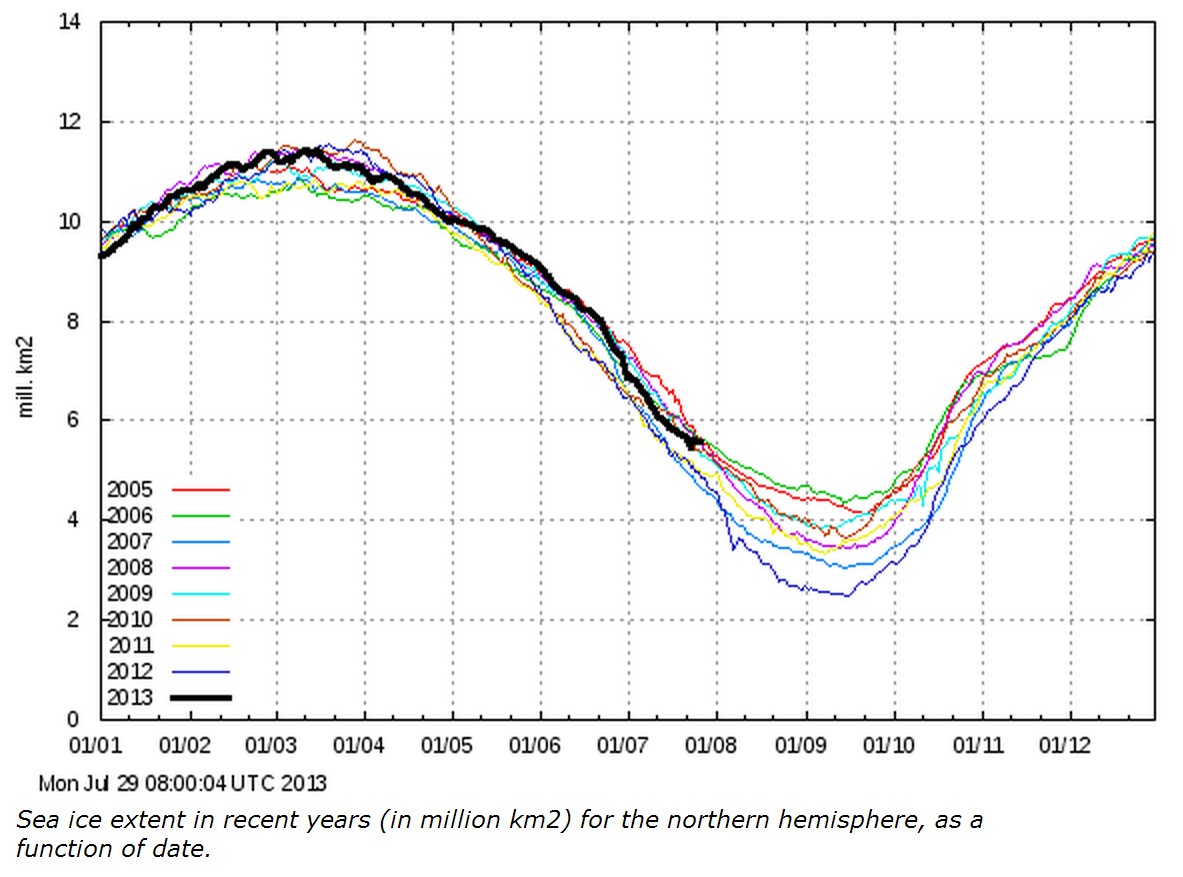Arctic cyclone chews up rotten northern sea ice
The Canadian Press July 28, 2013
Cyclones can destroy large amounts of ice very quickly.
“In 2009, we actually documented one of these events in which large, multi-year ice floes — Manhattan-sized — broke up in a matter of minutes,” said Barber.
This year’s storm over the Beaufort Sea formed about mid-week and is expected to die out on the weekend.
It isn’t as strong as last year’s, but the ice is thinner and weaker. As well, the ice has already been pummelled by earlier storms.
Barber said the ice is getting so weak that new categories have had to be created for it.
“We have a whole new class of sea ice in the Arctic, which we’re calling ‘decayed ice,”‘ he said.
“We started seeing it in 2009. It’s extremely weak.”Barber said the research icebreaker CCGS Amundsen can do 13.5 knots in open water. Through decayed ice, it can do 13 knots
Changing sea-ice cover is increasingly being linked to southern weather patterns. The jet stream, which strongly influences weather at mid-latitudes, is driven by temperature differences between the Arctic and the equator, a difference that shrinks with the sea ice.
Ice coverage is slightly about last year’s record low but still well below the 30-year average.
Much remains unknown about the role of Arctic cyclones in the annual freeze-thaw cycle. Back when the sea was thick and lasted for years, cyclones tended to spread the ice out and actually increase its extent, said Julienne Stroeve of the National Snow and Ice Data Center in Boulder, Colo. Now, when ice gets spread out, it simply breaks up and disappears.
“As our ice cover has thinned, some of our old rules are changing,” said Stroeve.
Arctic cyclone chews up rotten northern sea ice | Alaska Dispatch
You can see the rotten, decayed ice here. Ice extent is more than double last year’s “record low” and has been moving horizontally for almost a week.
COI | Centre for Ocean and Ice | Danmarks Meteorologiske Institut



Reblogged this on The Firewall.
But it’s rotten, low down, dirty, stinking ice!
“Now look hear, seeee!”
If Jimmy Cagney were here, he’d blast it to smithereens with his .38 police special.
You forgot decrepit.
LOL
I wonder when Barber will realize that charging round the Arctic in an icebreaker is the cause of ‘decayed’ ice’. There is a strong correlation between the amount of ice in the Arctic and the number of icebreakers out there chopping it up.
As pointed out a couple of days ago – that is the old DMI graph. The correct one to use is:
http://ocean.dmi.dk/arctic/icecover.uk.php
“The plot above replaces an earlier sea ice extent plot, that was based on data with the coastal zones masked out. This coastal mask implied that the previous sea ice extent estimates were underestimated. The new plot displays absolute sea ice extent estimates. ”
With the new plot, things are looking even worse for the alarmists.
The “correct one”
ROFLMAO
BEST WAG! 😉
Or is it the Correct WAG!
So they just found another 4 million sq. km of february ice?
The only thing “decayed” is Barber’s obsessive-compulsive alarmist head!!
Looking at the graph you can see that we only need a year like 2006 to totally shut the alarmist loons up!! Come on sea ice … drive a stake through the heart of the slime sucking pigs from hell alarmists.
The DMI is obviously in the pay of Big Oil.
“Decaying arctic sea ice” is the last refuge of the unrepentant Warmist. They have nothing else to sell.
The only thing that has worn thin is the constant Alarmist harping about an impending global meltdown. I’m convinced that many of the most vocal believers in AGW are emotionally and psychologically disturbed.
Has global warming turned in the North Pole into a pool? The answer is no, but most articles say yes. As Adolf Hitler used to say: Repeat a lie often enough and people will start to believe it.
http://www.justfactsdaily.com/has-global-warming-turned-the-north-pole-into-a-lake
“…Barber said the research icebreaker CCGS Amundsen can do 13.5 knots in open water. Through decayed ice, it can do 13 knots…”
According to their stats, the registered full speed is only 14 knots. And the story is based on the fact their ship can go .5753 MPH faster through open water.
If it’s speed they want, don’t go through the ice. Go around. I hear the northwest passage is open and can be navigated by a ROWBOAT.
Another “icebreaker”, the RMS Titanic, was able to get up to 21 knots. How much longer would it have stayed afloat if that ‘berg had only been “decayed ice”?
/sarc
Bollocks!
JAXA SIE is the highest since 2008 and only a smidgen below 05, 06 & 08 levels.
http://i255.photobucket.com/albums/hh154/crocko05/Daily%20Arctic%20Sea%20Ice%20Extent/JAXASIE28thJuly2013_zpsd4bf05a4.jpg
Ice extent has been above 7 million sq km’s for the past 14 days, since the 14th.
http://i255.photobucket.com/albums/hh154/crocko05/Daily%20Arctic%20Sea%20Ice%20Extent/JAXASIEJuly2013_zpsd569bcd6.jpg